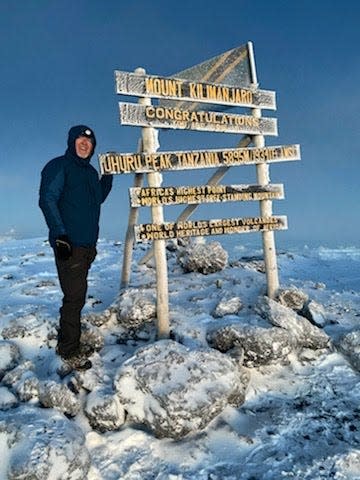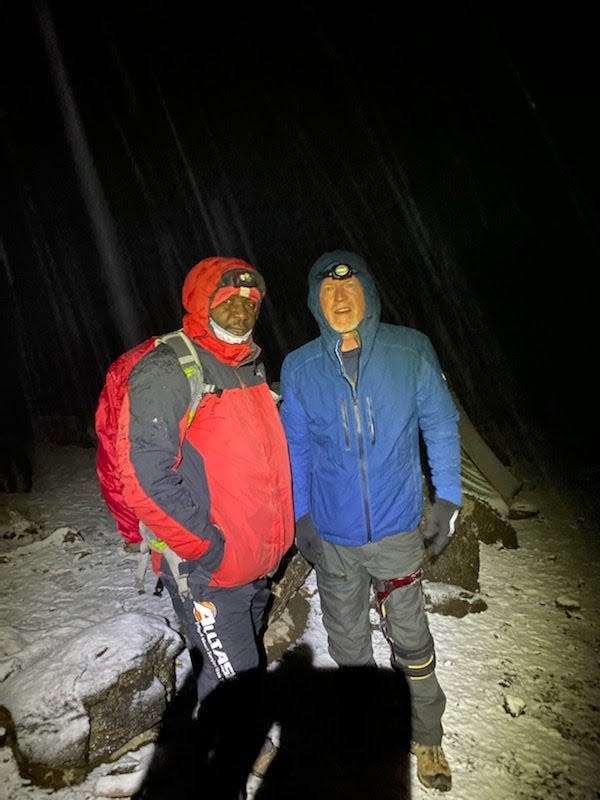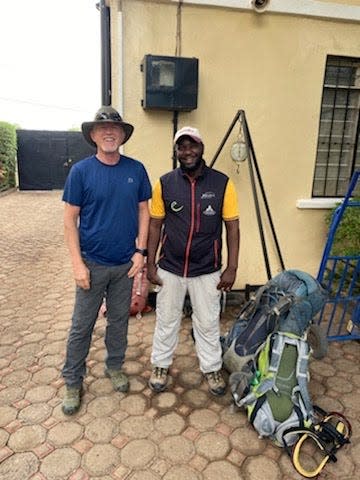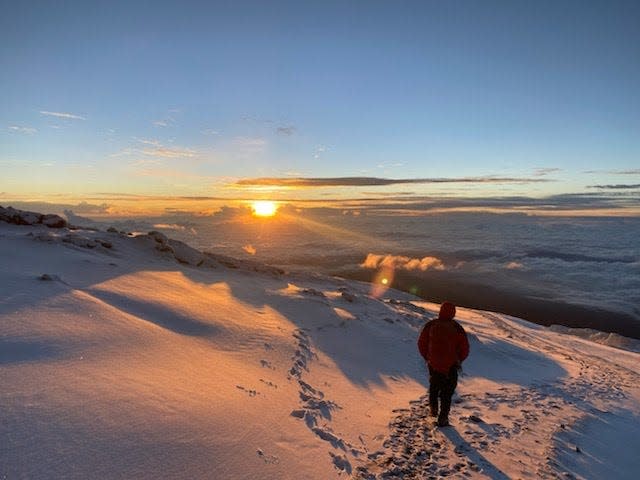Las Crucen summits Mount Kilimanjaro on second attempt, 3 years after debilitating injury

Editor's note: This is the first in a series of hometown heroes — southern New Mexico residents who complete acts of heroism or otherwise serve as an inspiration. We'll feature one hometown hero a month in 2022. To nominate someone, email LRomero@lcsun-news.com.
LAS CRUCES – On his first attempt to scale Africa's tallest mountain, Las Cruces businessman David Hill failed. His leg fractured about 4,000 feet from the summit of Mount Kilimanjaro and he had to be carried down the mountain.
Hill, now 62, is the owner of Ride On Sports, a sports accessory store for biking, hiking, backpacking and other activities. He was determined to head back to Africa and take a picture atop the tallest free-standing mountain in the world.
In December 2021, less than three years after suffering the debilitating injury, Hill successfully summited Mount Kilimanjaro, which stands 19,341 feet tall.
“So many people have said to me, ‘you inspire me to do this and do that,’” Hill said. “That wasn't my purpose, but I'm certainly glad that people are inspired.”
First attempt and rehabilitation
Hill said when he started trail running — a combination of running and hiking — about five years ago, summitting Kilimanjaro soon became a goal of his. Hiking the numerous trails in the Mesilla Valley was his training.
In January 2019, he made his way to Tanzania for the first time with his brother-in-law, who is also a hiker. Hill explained that there are about eight trails up Kilimanjaro ranging from four to nine days. He and his brother-in-law partnered with the local guide group Zara Tours and ventured up on the seven-day path.

On the fifth day, Hill slipped and his left tibia snapped. Rain was pouring down and he said there was no way for an evacuation team to reach them. Hill said Salim, a trail guide, carried him on his back down to about 11,000 feet in elevation to meet the evac team.
“There I was laying instead of summitting,” Hill remembers. He flew back home several days later in a full cast.
Back home, he started an Instagram account to document his recovery and time in physical therapy. After undergoing corrective surgery through Southwest Sport & Spine Center to address the trauma to his leg, he ended up with a six-inch metal plate and nine screws. Recovery along with PT at Fyzical Therapy & Balance Centers took nearly a year, but by the end of 2019 Hill said he wasn’t making progress.
“They went and had an MRI on the knee and I had ruptured my ACL. So I don't have an ACL, I had torn my PCL and I tore my meniscus,” Hill said.

Doctors agreed that operating would not fix the damage, so Hill had to “embrace” using a carbon fiber brace which now acts as the stabilizer for his knee.
About a year ago, Hill said he brought up attempting Kilimanjaro again with his family. The response was overwhelming support.
More: Indigenous peoples hike into Organ Mountains for sunrise blessing
“I set up a training schedule for six months which included four three-mile runs a week, one six-mile run a week,” Hill said. He also joined a friend trail running the southwest peaks and hiked the Organ Needle every three weeks for vertical training. By mid November, he ventured up the Needle one more time and said he realized he was physically ready for Africa.
“I did the Needle hike all by myself and it was four hours and 15 minutes, which is up and down which is extremely fast. I realized going up that I was not fatigued at all. It was simply just doing it,” he said.
Second attempt and what's next
Hill started up Mount Kilimanjaro again Dec. 6, with nearly the same group of guides who took him on his original attempt. The group followed a four-day path this time. He said he reached the summit before sunrise on Dec. 9 and was the second person who reached the summit that day.

“It was just kind of one of those moments where I'd been working on it for so long. It had been such a focus and there was such a relief. I mean, I had such a great time and there was no physical issues,” he said.
And now that he’s accomplished his long-held goal, Hill said he doesn’t feel the need to go back again. That chapter has ended and he’s ready to take on his next challenges. He said he and a friend have plans to climb Mount Whitney in California in early spring 2022 and then travel 40 miles from rim to rim of the Grand Canyon in Arizona.
He encouraged people to go out and explore what Las Cruces and the surrounding area has to offer in ways of hiking trails, physical activity and natural views.
"There’s so many hikes around here that … people don’t even know about,” he said. “Literally if you wrapped around the valley all the way up to Hatch and back, there’s probably 30 world-class hikes.”
It may be tough at first, he said, reminiscing about his own start. But he now takes those challenges in stride.
Leah Romero is the trending reporter at the Las Cruces Sun-News and can be reached at 575-418-3442, LRomero@lcsun-news.com or @rromero_leah on Twitter.
Here are five trails nearby Las Cruces for beginning hikers:
Baylor Pass National Recreation Trail
This trail cuts a path through the Organ Mountains and can be accessed from trailheads off Baylor Canyon Road on the west side or within Aguirre Spring Campground on the east side. The west approach offers a 3.55-mile hike to Baylor Pass saddle, where you will have expansive views of the Mesilla Valley to the west and the Tularosa Basin to the east. The trail is well-used though more strenuous than Dripping Springs or Soledad Canyon. Leashed dogs are allowed.
Directions to the west-side trail-head: Take US 70 east toward Alamogordo. Travel to the Baylor Road exit. Travel south. In approximately 1.5 miles you will see a national monument sign. In another 0.5 mile the trailhead parking is on your left.
Dripping Springs/La Cueva
The Dripping Springs Natural Area has over four miles of easy hiking trails, including the Dripping Springs Trail, which shows off desert scrub and low elevation pinon-juniper and oak woodlands. The area also boasts excellent wildlife viewing opportunities. Also, there's a trail to La Cueva rock shelter, an archeological site, as well as picnic sites and a visitor's center with exhibits. Dripping Springs is open from 8 a.m. to sunset during winter months and there is a $5 fee.
Directions: Dripping Springs Natural Area is located 10 miles east of Las Cruces, on the west side of the Organ Mountains. From Exit 1 on Interstate 25, take University Avenue/Dripping Springs Road east to the end.
Picacho Peak
The Picacho Peak hiking loop is about 4 miles and ascends 1,200 feet. The hike affords views of Box Canyon to the west, the Trackways National Monument to the north, and the verdant Mesilla Valley to the east. It's a strenuous hike.
Directions: Turn north on Picacho HIlls Drive from Picacho Avenue. Drive 2.1 miles making sure you stay left to proceed on Barc—elona Ridge as you drive up the hill. Turn right on Anthem and drive for 1.1 miles where you will come to a T-junction. Turn right on Picacho Loop. Pavement ends in 0.1 mile. Continue another 1.5 miles on gravel to the parking area.
Soledad Canyon
The Soledad Canyon Day Use Area is at the juncture of two canyons — Bar Canyon and Soledad Canyon — and is in the western foothills of the Organ mountains. The area includes the three-mile loop Bar Canyon Trail, which offers an easy and scenic hike.
Directions: The Soledad Canyon Day Use Area is on the west side of the Organ Mountains, 10 miles east of Las Cruces. From Exit 1 on Interstate 25, take University Avenue/Dripping Springs Road east for about 4.5 miles, then turn south on the Soledad Canyon Road. That road will turn east in a mile; follow it all the way to the end.
Tortugas 'A' Mountain
The small, hump-backed Tortugas Mountain rises above the East Mesa to an elevation of 4,928 feet. Often called "A" Mountain for the "A" etched on the west side of the mountain, the area offers several hiking and biking trails and routes to the summit. At the top, you'll find communication structures and astronomical observatories managed by New Mexico State University, though those are not for public use. The trails are popular.
Directions: The parking lots on the east and west side of the mountain are accessed from University Avenue/Dripping Springs Road, just east of the intersection with Sonoma Ranch Road.
This article originally appeared on Las Cruces Sun-News: Las Crucen summits Mount Kilimanjaro three years after leg injury

